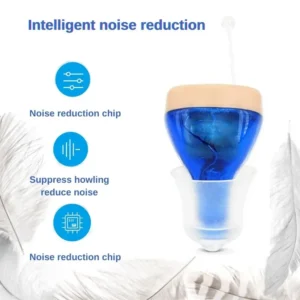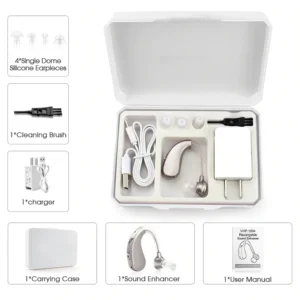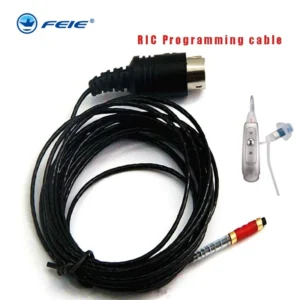
Hearing Aid Prices : The price of a hearing aid can vary widely depending on several factors such as the brand, model, features, and where you purchase it – “hearing aid price”. Basic hearing aids may start at a few hundred dollars, while more advanced models with cutting-edge technology can cost several thousand dollars per ear. Additionally, factors like warranty, fitting services, and ongoing support may also influence the price. It’s best to consult with an audiologist or hearing healthcare professional to determine the most suitable option for your needs and budget.
Hearing Aid Prices : Hearing aids are small electronic devices worn in or behind the ear that amplify sound. They are commonly used to help individuals with hearing loss hear more clearly and participate more fully in daily activities.
Here are some key components and features of hearing aids:
It’s important to note that there are different types and styles of hearing aids available to suit individual preferences and hearing needs. Additionally, proper fitting and adjustment by a qualified audiologist or hearing healthcare professional are crucial for maximizing the effectiveness of hearing aids.
Hearing Aid Prices : The price of hearing aids can vary significantly depending on factors such as brand, model, features, and the level of customization required. While there are several high-end hearing aids on the market, here are a few examples of some of the most expensive hearing aids:
Phonak Paradise P90: Phonak’s Paradise P90 is a premium hearing aid model with advanced features such as Dynamic Noise Cancellation, speech enhancement, and personalized sound adjustments. It also offers connectivity to smartphones and other devices. Prices for this model can range from $3,000 to $4,000 per ear.
Oticon More: The Oticon More is another high-end hearing aid that utilizes deep learning technology to analyze sound environments and provide a more natural listening experience. It offers features such as 360° sound processing and direct streaming from compatible devices. Prices for the Oticon More can range from $3,000 to $4,000 per ear.
Widex Moment: Widex Moment is known for its PureSound technology, which aims to deliver a more natural sound experience by eliminating delays and distortion. It also offers features like wind noise reduction and smartphone connectivity. Prices for the Widex Moment can range from $2,500 to $3,500 per ear.
Signia Styletto Xperience: The Signia Styletto Xperience is a stylish and technologically advanced hearing aid that offers features such as Own Voice Processing (OVP) for a more natural sound of your own voice, as well as Bluetooth connectivity and portable charging options. Prices for the Signia Styletto Xperience can range from $2,500 to $3,500 per ear.
ReSound ONE: ReSound ONE is a premium hearing aid model that features a unique M&RIE (Microphone & Receiver-In-Ear) design for improved directionality and sound localization. It also offers features such as personalized sound adjustments and direct streaming from compatible devices. Prices for the ReSound ONE can range from $2,500 to $3,500 per ear.
Hearing Aid Prices : These prices are approximate and can vary depending on factors such as location, provider, and additional services included with the purchase. It’s important to consult with a qualified audiologist or hearing healthcare professional to determine the most suitable hearing aid for your needs and budget.
Hearing Aid Prices : In South Africa, the price of hearing aids can vary depending on several factors, including the brand, model, features, and services bundled with the purchase. Generally, basic hearing aids may start at around R5,000 to R10,000 per ear, while more advanced models with additional features like Bluetooth connectivity or noise cancellation can cost upwards of R15,000 to R30,000 per ear or more.
It’s important to note that these are rough estimates, and prices can vary significantly depending on the specific requirements of the individual and the provider. Additionally, some healthcare plans or insurance policies may offer coverage or assistance for hearing aids, so it’s worth exploring those options as well. Consulting with a qualified audiologist or hearing healthcare professional is the best way to get an accurate assessment of the cost based on your needs.

Hearing Aid Prices : For quality hearing aids, one will want to look for several key features:
Digital Signal Processing (DSP): This feature helps to process sound in real-time, providing clearer and more natural sound quality.
Noise Reduction: High-quality hearing aids often have noise reduction technology to filter out background noise, allowing you to focus on speech and other important sounds.
Feedback Suppression: Feedback or whistling noises can be an issue with some hearing aids. Quality devices will have feedback suppression technology to minimize or eliminate this problem.
Directional Microphones: These microphones focus on sounds coming from specific directions, enhancing speech understanding in noisy environments.

Wireless Connectivity: Many modern hearing aids offer wireless connectivity, allowing you to stream audio from your smartphone, TV, or other devices directly to your hearing aids.
Customizable Settings: Quality hearing aids typically offer customizable settings to adapt to different listening environments and preferences.
Comfort and Fit: A comfortable and secure fit is essential for long-term wear. Look for hearing aids that are custom-molded or adjustable to fit your ears comfortably.
Durability and Warranty: Quality hearing aids are built to last and often come with warranties or guarantees to provide peace of mind.
Hearing Aid Prices : Some reputable hearing aid brands known for their quality include Phonak, Oticon, Widex, Siemens (now Sivantos), ReSound, and Starkey. However, the best hearing aid for you will depend on your specific hearing needs, preferences, and budget, so it’s essential to consult with an audiologist or hearing healthcare professional who can assess your hearing and recommend the most suitable option for you.
When considering durability in a hearing aid, you’ll want to look for features and qualities that ensure it can withstand daily wear and tear. Here are some aspects to consider:
Water and Dust Resistance: Look for hearing aids that are rated for water and dust resistance. While most hearing aids are not fully waterproof, many are resistant to moisture from sweat, rain, or humidity, which can help prevent damage.
Build Quality: Opt for hearing aids from reputable brands known for their durable construction. High-quality materials and robust designs can contribute to longevity.
Warranty: Choose hearing aids that come with a good warranty or guarantee. This can provide protection against defects or malfunctions and ensure that you have support if issues arise.

Feedback from Users: Read reviews and seek recommendations from other users to gauge the durability of specific hearing aid models. User feedback can provide valuable insights into how well a hearing aid holds up over time.
Regular Maintenance: Proper maintenance and care can also contribute to the durability of your hearing aids. Follow the manufacturer’s guidelines for cleaning and storage, and have your hearing aids serviced regularly by a qualified professional.
Hearing Aid Prices : Some hearing aid models known for their durability include those with nano-coating technology to repel moisture and debris, as well as models designed with robust housing materials. However, regardless of the specific model, taking good care of your hearing aids and following best practices for maintenance can help ensure they last as long as possible.
Hearing Aid Prices : Hearing loss is a common condition that occurs when there is a partial or total inability to hear sounds in one or both ears. It can affect people of all ages and can be caused by various factors. Here are some key points about hearing loss:
Hearing Aid Prices : If you suspect you or someone you know may have hearing loss, it’s essential to seek evaluation and treatment from a qualified healthcare professional. Early detection and intervention can help manage the condition effectively and improve quality of life.
Hearing aid prices have been gradually decreasing in recent years, and there are a few key factors contributing to this trend:
While these factors are contributing to lower prices, the cost of hearing aids can still vary widely based on features, brand, and customization. It’s a good idea to compare different options and consider both traditional and OTC hearing aids to find the best fit for your needs and budget.
Hearing aid price: The average price of hearing aids can vary widely depending on the type, features, and brand. As of 2024, the typical cost for a pair of hearing aids ranges from about $2,000 to $7,000.
Here’s a rough breakdown:
Keep in mind that these prices typically don’t include additional costs like fittings, follow-up appointments, or any required batteries and accessories. Many people also consider insurance coverage, financing options, or discounts offered by hearing aid providers.
How to Manage Tinnitus at Home: If tinnitus is mostly noticed in quiet situations, first you should try using a white noise machine to mask the noise. If you don’t have a white noise machine, a fan, soft music or low-volumed static radio will help.




How do you deal with tinnitus? If tinnitus is mostly noticeable in quiet situations, try using a white noise machine to mask the noise from tinnitus. If you don’t have a white noise machine, a fan, soft music or low-volume radio static also may help.